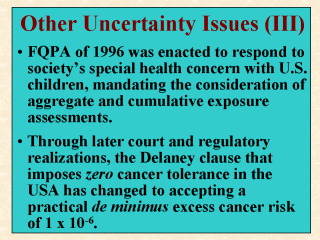| front |1 |2 |3 |4 |5 |6 |7 |8 |9 |10 |11 |12 |13 |14 |15 |16 |17 |18 |19 |20 |21 |22 |23 |24 |25 |26 |27 |review |
 |
The society's
risk perception also has a great deal to do with how health risk assessment (RA) and hence
how risk characterization (RC) is performed. This level of risk perception may later be
translated into practice through health laws or regulations, and eventually complicate the
RA process. For example, through the U.S. Food Quality Protection Act (FQPA) of 1996, the
U.S. government mandates the consideration of aggregate and cumulative exposure
assessment. In response to this mandate, USEPA (1999a, 2000b) proposed different
approaches to calculating the overall aggregate and cumulative MOE (margin of exposure)
and HX (hazard index). The derivations of these MOE and HX were briefly discussed in Slide
14. Additional efforts are now launched by USEPA and the scientific community to come up with (more) effective assessment models to estimate exposures from ingestion of drinking water. It is also in part due to FQPA that children health recently becomes one of the most important regulatory initiatives (USEPA, 1999c), for which the U.S. government proposed to use an additional uncertainty factor of up to 10 (USEPA, 1999b). Another example of regulatory implication is the Delaney clause of the U.S. Federal Food, Drug, and Cosmetic Act that imposes a zero cancer tolerance for processed foodstuffs or food additives. Partly through subsequent court and regulatory realizations, this imposition eventually has led to a compromised acceptance of the practical de minimus excess risk of 1 x 10-6 (one in 1 million) or less as free of cancer risk (see Slide 10 of Lecture 3). |